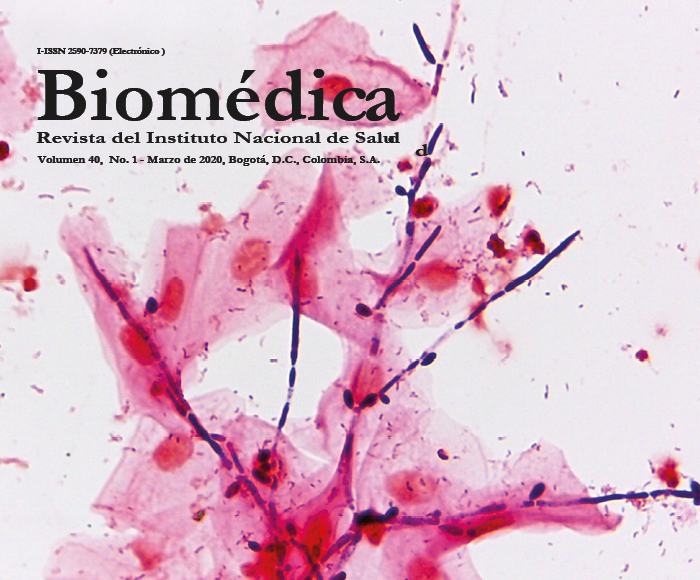Acute intermittent porphyria: A case report
Abstract
The term ‘porphyria’ comes from the Greek ‘porphyra’. It refers to a heterogeneous group of metabolic disorders caused by the enzymatic deficiency in the biosynthesis of the heme group. Acute intermittent porphyria is caused by a deficiency of the porphobilinogen deaminase enzyme.
A 40-year-old woman presented with abdominal pain for ten days (which required laparotomy that evidenced no surgical pathology), severe hydroelectrolytic disorder due to hyponatremia and resistant hypokalemia, persistent tachycardia and hypertension. Seven days later, she developed acute flabby quadriparesis and presented a single generalized tonic-clonic convulsive crisis. Neurophysiological studies supported mixed axonal polyneuropathy and urine results of porphobilinogen and porphyrins were elevated. After acute intermittent porphyria was diagnosed, hemin was administered, which stabilized the patient’s clinical signs and normalized the porphobilinogen.
The prevalence of this entity is 1 in 2,000 people. It is an autosomal dominant disease, which affects mainly women between 20 and 40 years of age. This entity manifests with neurological and visceral symptoms. Management consists of hematin and dextrose administration avoiding hypotonic solutions because of the risk of exacerbating hyponatremia.
Downloads
References
Woolf J, Marsden J, Degg T, Whatley S, Reed P, Brazil N, et al. Best practice guidelines on first-line laboratory testing for porphyria. Ann Clin Biochem. 2017;54:188-98. https://doi.org/10.1177/0004563216667965
Pallet N, Karras A, Thervet E, Gouya L, Karim Z, Puy H. Porphyria and kidney diseases. Clin Kidney J. 2018;11:191-7. https://doi.org/10.1093/ckj/sfx146
Fontanellas A, Ávila M, Berraondo P. Emerging therapies for acute intermittent porphyria. Exp Rev Mol Med. 2016;18:1-13. https://doi.org/10.1017/erm.2016.18
Cárdenas J, Guerrero C. Acute intermittent porphyria: General aspects with focus on pain. Curr Med Res Opin. 2018;34:1309-15. https://doi.org/10.1080/03007995.2018.1435521
Bissell D, Anderson K, Bonkovsky H. Porphyria. N Engl J Med. 2017;377:862-72. https://doi.org/10.1056/NEJMra1608634
Stein P, Badminton M, Rees D. Update review of the acute porphyrias. Br J Haematol. 2017;176:527-38. https://doi.org/ 10.1111/bjh.14459
Yang J, Chen Q, Yang H, Hua B, Zhu H, Yu X, et al. Clinical and laboratory features of acute porphyria: A study of 36 subjects in a Chinese tertiary referral center. Biomed Res Int. 2016;2016:392763539. https://doi.org/10.1155/2016/3927635
Arora S, Young S, Kodali S, Singal A. Hepatic porphyria: A narrative review. Indian J Gastroenterol. 2016;35:405-18. https://doi.org/ 10.1007/s12664-016-0698-0
Neeleman R, Wagenmakers M, Koole-Lesuis R, Mijnhout S, Wilson J, Friesema E, et al. Medical and financial burden of acute intermittent porphyria. J Inherit Metab Dis. 2018;41:809-17. https://doi.org/10.1007/s10545-018-0178-z
Fugate J, Rabinstein A. Posterior reversible encephalopathy syndrome: Clinical and radiological manifestations, pathophysiology, and outstanding questions. Lancet Neurol. 2015;14:914-25. https://doi.org/10.1016/S1474-4422(15)00111-8
Puy H, Gouya L, Deybach J. Porphyrias. Lancet. 2010;375:924-37. https://doi.org/ 10.1016/S0140-6736(09)61925-5
Bornstein S, Allolio B, Arlt W, Barthel A, Don-Wauchope A, Hammer G, et al. Diagnosis and treatment of primary adrenal insufficiency: An endocrine society clinical practice guideline. J Clin Endocrinol Metab. 2016;101:364-89. https://doi.org/10.1210/jc.2015-1710
Sterns R. Disorders of plasma sodium - causes, consequences, and correction. N Engl J Med. 2015;372:55-65. https://doi.org/10.1056/NEJMra1404489
Albers J, Fink J. Porphyric neuropathy. Muscle Nerve. 2004;30:410-22. https://doi.org/10.1002/mus.20137
Aarsand A, Villanger J, Stole E, Deybach J, Marsden J, To-Figueras J, et al. European specialist porphyria laboratories: Diagnostic strategies, analytical quality, clinical interpretation, and reporting as assessed by an external quality assurance program. Clin Chem. 2011;57:1514-23. https://doi.org/10.1373/clinchem.2011.170357
Montoya M, Barranco LA, Herrera F. Porfiria aguda: dilema diagnóstico y manifestaciones neuroendocrinas. Acta Med Colomb. 2017;42:140-3.
Tchernitchko D, Tavernier Q, Lamoril J, Schmitt C, Talbi N, Lyoumi S, et al. A variant of peptide transporter 2 predicts the severity of porphyria-associated kidney disease. J Am Soc Nephrol. 2017;28:1924-32. https://doi.org/10.1681/ASN.2016080918
Naik H, Stoecker M, Sanderson SC, Balwani M, Desnick RJ. Experiences and concerns of patients with recurrent attacks of acute hepatic porphyria: A qualitative study. Mol Genet Metab. 2016;119:278-83. https://doi.org/10.1016/j.ymgme.2016.08.006
Some similar items:
- Juliana Buitrago, Sandra Viviana Santa, Acute intermittent porphyria presenting as spontaneous hemothorax , Biomedica: Vol. 29 No. 3 (2009)
- Álvaro Sanabria, Luis Carlos Domínguez, Charles Bermúdez, Adriana Serna, Evaluation of diagnostic scales for appendicitis in patients with lower abdominal pain , Biomedica: Vol. 27 No. 3 (2007)
- Tomas Carvajal, Diana L. Franco, Adriana Martínez, Iván M. Peña, Wernicke’s encephalopathy and polyneuropathy associated with vitamin B complex deficiencyafter a bariatric surgery , Biomedica: Vol. 32 No. 4 (2012)
- Blair Ortiz, Yesyka Jaramillo, Christian Rojas, X-linked epileptic syndrome by protocadherin 19 mutation associated with leukoencephalopathy and posterior reversible tractopathy , Biomedica: Vol. 38 No. 4 (2018)
- Blair Ortiz, Carolina Hernández, Norma Carolina Barajas, A radiological and clinical description of metastatic angiosarcoma simulating a hydatid cyst , Biomedica: Vol. 39 No. 3 (2019)

| Article metrics | |
|---|---|
| Abstract views | |
| Galley vies | |
| PDF Views | |
| HTML views | |
| Other views | |

























